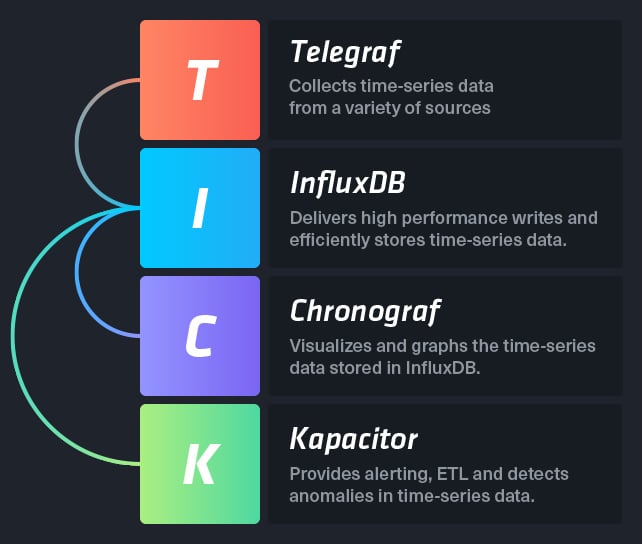TICK Stack Update: InfluxDB Release Candidate, Kapacitor & Chronograf v0.10
By
Todd Persen
Product
Use Cases
Company
Jan 28, 2016
Navigate to:
We are excited to announce several new releases today to the TICK stack, Kapacitor and Chronograf v0.10!
What’s the TICK stack?
The TICK stack is the first purpose-built, end-to-end solution for collecting, storing, visualizing and alerting on time-series data at scale. All the components of the stack are designed to work together seamlessly. The TICK stack is InfluxData’s vision for a complete data platform to manage time-series data.

InfluxDB v0.10 Release Candidate
We’ve all been eagerly awaiting the release of v0.10 and thanks to the testing, benchmarking and contributions of the community we are pleased to announce the immediate availability of the v0.10 Release Candidate now available on our downloads page.
For those who haven’t been tracking the progress of InfluxDB the last few months, here’s what you need to know in a nutshell:
- TSM replaces b1 and bz1 as the default storage engine with the benefit of better performance and storage compression
- We've added a migration tool to convert b1 and bz1 shards to the TSM format (official docs coming next week) right now
- Performance improvements to the query engine
- Incremental features and stability added to the cluster refactoring (still targeted for non-production environments, but reach out to us at [email protected] if you're looking to run clusters in production - we can help!)
Some general advice for those eager to test the clustering:
- Don't try to upgrade an existing v0.9.x cluster for now - start with a fresh cluster. The upgrade logic for clusters isn't able to be automated, but our support team can help you if you need to migrate your data. (Get in touch with us at [email protected] if you need help.)
- You can now run distinct data and meta nodes for more complex deployments. However, we don't yet have documentation available for this (expect this next week), so the simplest configuration is to make each node handle both data and meta. (This is the closest to the configuration that the previous clustering implementation offered.)
- The configuration format has changed slightly from v0.9.x, so you'll want to start with a fresh config when installing the package.
We are going to assume your next question is, “When will v0.10.0 GA ship?” The short answer is, “When the quality is high enough to earn the label.” To this effect, the more feedback we can get from you, the faster we can fix any remaining bugs and move towards GA. If you run into issues, no matter how big or small, open up an issue on the GitHub repo and provide as much detail as possible. Even if you’ve seen the issue before in a previous release, it will help us to know that you’re still seeing it. We’ll be aiming to respond to every Release Candidate issue within a day.
Kapacitor v0.10
Three exciting things to talk about with the latest release of Kapacitor:
- Anomaly Detection: Support for User Defined Functions (UDFs) so that it is easy to integrate your favorite anomaly detection algorithms.
- Alerting Integrations: New in this release are community contributed integrations to HipChat, OpsGenie and Alerta.
- Dead Man's Switch: You can now configure a switch by individual task or globally for all tasks, that will trigger an alert if a task doesn't receive data for a configurable duration.
Read Nathaniel Cook’s blog post and watch his screencast for more details.
Chronograf v0.10 Release Candidate
The latest release of Chronograf is rounding the corner and here’s what’s coming in v0.10 and ready for testing now:
- Template Variables: You can now apply a value across multiple queries.
- Time Ranges: You can globally apply selected time ranges in the query builder and manually.
- Tags: Using template variables for tags now means you don't have to duplicate groups of visualizations across dashboards.
Read Will Faurot’s blog post with short GIF demos for more details.
What’s next?
- Learn more about the TICK stack and visit our testimonials page to learn how companies are using it to manage their time-series data
- Download the TICK Stack and Get Started
- Need immediate help? Check out our support options.
